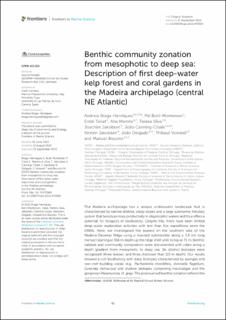| dc.description.abstract | The Madeira archipelago has a unique underwater landscape that is characterised by narrow shelves, steep slopes and a large submarine tributary system that boosts primary productivity in oligotrophic waters and thus offers a potential for hotspots of biodiversity. Despite this, there have been limited deep-water exploration activities with less than five expeditions since the 1960s. Here, we investigated the seabed on the southern side of the Madeira-Desertas Ridge using a manned submersible along a 3.8 km long transect starting at 366 m depth up the ridge shelf until its top at 73 m. Benthic habitats and community composition were documented with video along a depth gradient from mesophotic to deep sea. Six distinct biotopes were recognised (three deeper, and three shallower than 115 m depth). Our results showed a rich biodiversity with deep biotopes characterised by sponges and non-reef-building corals (e.g., Pachastrella monilifera, Viminella flagellum, Eunicella verrucosa) and shallow biotopes comprising macroalgae and the gorgonian Paramuricea cf. grayi. The pronounced benthic zonation reflects the steep environmental gradient that includes high topographic variation, heterogeneous substrates, and bidirectional regular wave-motion at the shallow mesophotic part. Together with biotic factors, such as low density of sea urchins and presence of predatory fish, this environment with unusual deep light penetration, a mesoscale cyclonic eddy, and deep wave-motion, has allowed the establishment of a mature deep-water kelp population of Laminaria ochroleuca in the plateau (max. >100 individuals p/100 m2). At the same time, a conspicuous coral fauna was observed on a wide range of soft to hard bottoms with several species taking advantage of the favourable hydrodynamic regime and seawater properties together with substratum availability to create coral gardens. These habitats were previously not known from Madeira, and their newfound discovery in the archipelago merit further investigation and protection. | en_US |
